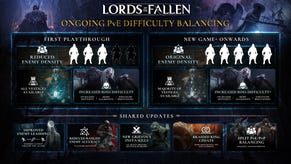PS4 at home: EU set-up and UI impressions ahead of Friday's launch
PlayStation 4 launches across Europe this Friday. Patrick Garratt takes you through the hardware, UI and general experience of wallowing in Sony's next generation.
As a grown-up toy, and as a serious games machine, PS4 appears to be pretty spectacular. I could write about it all day. I get bored of everything extremely quickly, but PS4's sucking up far too much of my spare time at the moment. Well done, Sony. Feels real good.
I've been playing around with PS4 since last week. Sony switched on its European servers over the weekend, so now I'm able to give you some decent impressions. The full weight of the EU public doesn't hit till this Friday, but anyone using a retail PS4 in Europe at the moment has the full experience if they have a friends list. I'm based in France, and I'm now able to view the Store, stream gameplay, use social media and all the rest of it.
So. This is what PS4 is like. I'm talking here about the hardware itself and the practicalities of the UI. I'll write about the games later this week.
Shiny Apple
Out of the box and through set-up, the machine has an undeniable "Apple" feel. Pieces of protective plastic peel satisfyingly into your hands, and build quality is solid and weighty throughout. It's shiny and new and everything works. You can’t imagine it breaking any time soon. There’s remarkably little frustration in set-up, which is generally un-Sony-like, if I'm being frank. The console replaces your PS3 easily; you remove the power lead and the HDMI cable and push them into the back of the PS4. As with the rest of set-up, there's no fuss.
Setting up your account and the settings in Firmware is, again, surprisingly slick. You turn it on, connect to your wireless, it automatically finds the time and date, you plug in the camera for some face-scanning (which works: I had no problem with it at all) and you’re done. You sign into your PSN account, do some agreeing to terms and you’re on the dash. It takes ten minutes. Without question, it’s the best box-to-play set-up Sony’s ever built.
The UI, then. You’ve all seen it by now, but whatever. PS4’s user interface is successful because it masks something hideously complex with a believable veneer of simplicity. The main section of the UI is a series of large blocks. There’s What’s New, which is populated by friends’ activity; The Playroom, a small suite of mini-games to play with the camera; any games you’ve been playing; Live from PlayStation, which comprises streams of people playing games, Twitch, Ustream and an “interactive” section (although every time I look at that it just tells me there’s no broadcast available, so I’m not entirely sure what that’s for); a web browser, which, unlike Vita’s ridiculously bad effort, is fast and renders perfectly; and “Library”. I’m thankful the main sections of the UI have been pared back from the PS3’s XMB; it's blatantly obvious how to launch any game or app.
Above the main UI blocks is a sparsely populated upper tier of icons. You have the Store, a notifications image, a friends icon, your avatar and name, a trophies icon and the time. If you push up on the pad from the main UI blocks, a new version of the XMB evolves from the smaller upper icons and pushes the main blocks down. As well as the aforementioned icons, you get messages, party, settings and power. The drop-downs from the old XMB are gone, and everything fits on one screen, so there’s no scrolling left and right. The combination of the main UI and new XMB offers greater complexity through clearer design. If you want the parental controls, you go into settings and change them. If you want to speak to a friend, you go to the friends bit. It’s straightforward.
The first block in the UI is What's New. You pull down on it to get a three-column feed of friends activity updates intermingled with app ads. The friends updates tell you who’s been playing what and links to any streaming broadcasts. You’ll see who’s achieved which Trophies, any screens or videos which have been shared from the Share button, and you can even “like” every update.
I haven’t been able to fiddle with the way PS4 handles multiple users, but when you boot it up it asks you if you’re a user registered on the machine or a guest. On the log-in screen, a camera window searches for your face and controller, so you don’t even have to press a button. If it sees you and the coloured pad on the back of the controller it signs you in and you move onto the dash. I’m assuming the camera will log several people into the right accounts automatically, but I’ve yet to see this work.
Unnoticeable
The process of playing a video game is kind of important to a video game console, and PlayStation 4 does a great job of getting you from disc or download to play with the minimum of fuss. Putting Killzone in for the first time, for instance, gave me an "installing" bar, and I was then up and playing in less than five minutes. I didn't time it, but it was make-a-cup-of-tea-ish. A few minutes, tops. It was the same with Call of Duty: Ghosts. There was an install wait, but it was hardly noticeable. Like, I didn't notice it. I saw the install bar, did something, came back and I was playing.
When you download something from the store – Resogun will probably be the first thing you grab, especially if you’re a Plus sub – the progress bar is added under a game icon in the main UI bricks. You can’t get lost. No more flicking into active downloads, or whatever. It’s just there.
You can pull down on any of the game icons in the main UI for additional information. This is a genius feature. You can drop through the home-screen to an overview page which shows DLC, friends’ activities with that game, general information and even links to Facebook pages which open in the in-built browser. This section appears to be populated by publishers, as Assassin's Creed 4 has some blank space in it at the moment, although this may be down to the fact the machine isn't out in Europe yet.
My biggest gripe with the UI in general (or at all, thinking about it) is that you can’t customize the positions of icons. You also can’t delete stock apps (I don’t want a Music Unlimited logo in there, thanks). Whatever app you used last is pushed to the front of the queue, but I can’t see that ending well after a few years of use and 60 games on the drive. There's the Library, yes, but it seems a bit odd.
There's more
A few other things need mentioning. I have to say something about the controller. DualShock 4 is a work of art. It was obvious Sony had done something special when I saw it at E3 in the summer, but you don’t appreciate just what a triumph it truly is until you use it for prolonged periods. It's so comfortable and well-made that it's hard to imagine playing with anything else once you get used to it. The touch-pad's much more sensitive than I remember it being in LA and Sony's nailed the triggers. Really nice.
Also, the streaming tech works with no hitch. I didn't think it would, but there it is. You go into the Live from PlayStation section, it populates with a bunch of streams, you click one and it starts playing. It does work. It's full of Americans at the moment, but I've never had a problem watching and the quality's easily good enough. Most people seem to be doing it through Twitch. To broadcast gameplay yourself, you just hit the Share button, sign into Twitch (or Ustream, if you're that way inclined) and off you go. You can include video from the camera and audio from the mic (which comes in the box and plugs into DS4) and show comments on-screen. All of this is viewable through the PS4 dash or on the web. You can tweet a notification that you've started streaming, and a box appears in the What's New section of the dash so your friends can see. Hopefully it won't all fall over when Europe comes online later this week, but considering there are hundreds of thousands of Americans using it already there's every reason to assume it won't. It's a different world.
As regards sharing, you can share grabs or videos to Twitter and Facebook by press the share button on the pad. This works faultlessly, as you're no doubt aware if, like myself, you've been watching your timeline flood with American pictures of Resogun over the past few weeks.
More stuff. Your Vita will automatically detect your PS4. A “PS4 Link” icon will appear on the Vita dash, offering you Remote Play and Second Screen options. And you can talk to PS4 (you don't need the camera; the controller can recognise your voice). The keyword is "PlayStation" and then others follow, such as "take screenshot," "power" or whatever else. This can be a little patchy, to be honest. Xbox One has the same feature, and there are a bunch of people saying the same thing: it doesn't work all the time. That's voice recognition for you, I guess. It'll get better with time, presumably.
But now is now. In summary, the process of installing and downloading software, seeing what your friends are doing, sharing screens and videos and actually playing games appears to have been refined on PS4 with common sense and considerable style over the last generation. I have no idea what Xbox One's like to set-up and use at home as I don't have one, so I can't compare. But PlayStation 4 does virtually everything it's supposed to do. I haven't felt let down by it.
It’ll be interesting to see what happens in Europe when everyone gets involved, but right now the only thing I can envisage PlayStation 4 being is a technical success. As a grown-up toy, and as a serious games machine, PS4 appears to be pretty spectacular. I could write about it all day. I get bored of everything extremely quickly, but PS4's sucking up far too much of my spare time at the moment. Well done, Sony. Feels real good.
Disclosure: Pat’s PS4, the PS4 camera and all the launch review software was supplied in a press pack by Sony.














